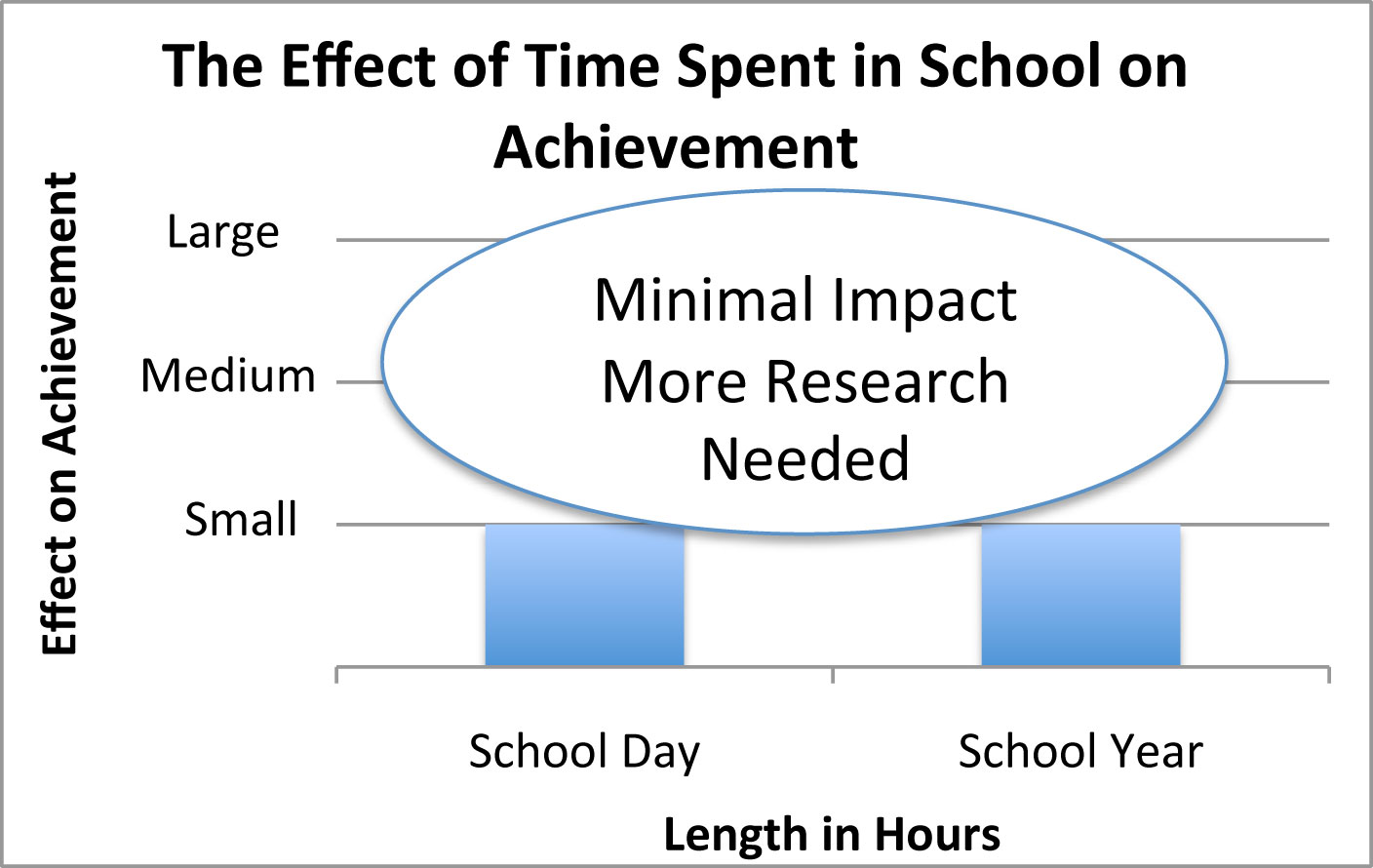Does a longer school year or longer school day improve student achievement scores?
Why is this question important? Extending the number of days students spend in session is a common intervention employed in school reform. Over the past 100 years, the average number of days students attend school has varied from as few as 140 days in rural area to over 195 days in urban areas. By the 1960s, the American school year began to standardize, with the majority of states establishing a 180-day calendar
School Days Per Year
|
180 or more days |
|
160 to 170 days |
|
No minimum |
Increasing the number of school days in a year comes at a cost. It is estimated that five additional school days can cost an elementary school with 300 students between $100,000 to $300,000 or anywhere from 10 to 20% over traditional costs. A corresponding improvement in student achievement is a reasonable expectation to make this intervention cost effective.
See further discussion below.

Source(s): Extending the School Day or School Year: A Systematic Review of the Research (1985-2009), 2010
Result(s):
Length of School Day
The study found a small or weak impact of an extended school day on student achievement, although the results suggested possible different effects across grades and socio-economic (SES) groups. The lack of rigorous research, including the absence of an effect size for length of school day, made it impossible to determine the magnitude of impact of a longer school day on student achievement.
Length of School Year
The study found some evidence linking an extended school year to improvement in student achievement. As was found in the research on a longer school day, the effects were not consistent across grades or SES groups. It should be noted there were no randomized controlled trials (RCTs). The quasi-experimental design of the studies reviewed and the significant design flaws in many of those studies advocate for increasing the quality of studies or implementing a large-scale RCT that would build a more compelling picture of the impact of a longer school year. In spite of the issues with the available research, there was little to suggest anything more than a minimal positive effect for this intervention.
Implication(s): Current research finds little to suggest that either practice-increasing the length of the school year or the school day-has a significant impact on student achievement. These are two more examples of structural interventions designed to meet school reform goals that are not supported by the data. The research currently available on these practices is insufficient in quantity and quality. Additional research that meets the standards set by organizations such as the Campbell Collaboration and the What Works Clearinghouse is desirable to build a knowledge base sufficient to guide informed decision making.
Unfortunately, there are significant obstacles to implementing an RCT at scale to answer the questions about the efficacy of lengthening the school year or the school day. The challenge in designing an RCT is in acquiring a sufficient number of units of analysis. An effectively designed RCT requires a randomization of schools at the level of a state or minimally a very large city. It may be better to conduct value-added analyses or well-designed quasi-experimental studies as alternatives for increasing our knowledge base. Policy makers would be wise to await additional research, including a cost effectiveness analysis, before investing in either practice to improve student scores.
Author(s): Erika A. Patall, Harris Cooper, and Ashley Batts Allen
Publisher(s): Review of Educational Research, American Educational Research Association (AERA), Sage Press
Study Description: This study is a review of the literature on the impact of time spent in school on student achievement between the years 1985 and 2009. It is not a meta-analysis because of the lack of consistent design research, making it impossible to establish meaningful magnitudes of impact and effect sizes for the two topic areas, length of school day and length of school year. The paper examines the history of school calendars in the United States over the past 100 years, provides a summary of the arguments for and against lengthening the school year and day, presents a synthesis of current research on these topics, and offers conclusions derived from the available research. There were no early experimental studies on the two topics, resulting in the authors' decision to include the available correlational research provided in the most extensive review up to that time derived from Karweit, 1985. The paper included all subsequent empirical studies on the lengthening of the school day and the year on student achievement. The study also reviewed any studies that looked at naturally occurring relationships between time spent in school and student performance.
The study looked at 1,390 articles on the length of school year and 818 documents on the length of the school day. Of those articles, 187 papers were on the topic of school year and 160 on the length of a school day were determined to be germane. Additionally, the authors contacted 153 education professionals to ensure that all critical articles had been identified in the literature search.
Definition(s): Research on the length of the school year and the school day are complicated because of the varying methods for defining these two terms.
- School year: The number of days that students attend school as identified in a school's calendar.
- School day: The number of hours that students are in attendance during a school day.
Three frequently used terms:
- The typical hours in a school day.
- The total number of annual attendance hours divided by the number of days of student attendance.
- The total number of annual instructional hours divided by the number of days of student attendance (excluding recess, lunch, school and classroom organizational and administrative activities, and classroom management).
Citation: Patall, E. A., Cooper, H., and Allen, A. B. (2010). Extending the School Day or School Year. Review of Educational Research, 80(3):401-436.
https://blogs.chicagotribune.com/files/extending-the-school-day-or-school-year-patall-et-al.pdf
